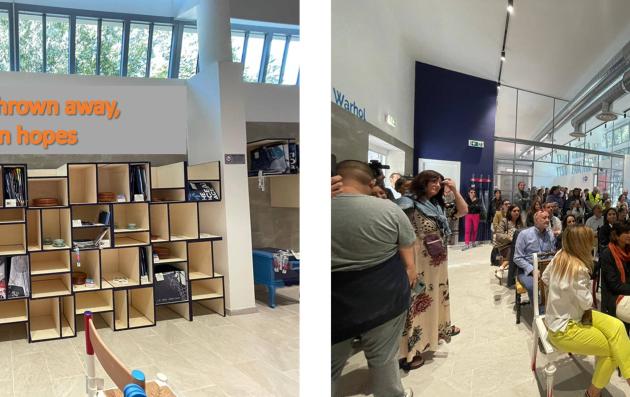Date of label : 29/10/2024
-
Genoa , Italy
-
Size of city : 564.684 inhabitants

Community event or exhibition.
Summary
C-City envisaged a sustainable circular economy strategy to transform key supply chains in Genoa (IT). The approach was based on three principles:
- Eco-design to redesign products, processes, services and business models in a circular way.
- Extending the life of goods and services, as much as possible.
- Reuse and upscaling, with a local Reuse Centre focusing on waste from electrical and electronic equipment, textiles and furniture, with the help of science and citizen participation.
The main tools to implement the actions are the Circular Hub, the Circular Desk, and a platform on the blue and green economy, to increase awareness and participatory dialogue between the municipality and multiple stakeholders.
The solutions offered by the Good Practice
The C-City Genoa Circular City project was proposed within the Action Plan Genoa 2050, approved by the Municipality of Genoa in 2021. It aims to transform Genoa by applying the principles of sustainability and circularity to strategic supply chains. Launched in 2022, the project was financed by the National Operational Programme for Metropolitan Cities 2014-2020 (PON Metro).
The project aligns with European networks to:
- Improve waste management by promoting prevention and upcycling solutions.
- Foster a sustainable and resilient city, through low-emission solutions to improve health and quality-of-life.
- Re-engineer waste collection schemes and encourage reuse on a neighbourhood scale through reuse centres.
- Incentivise and maximise bioeconomy solutions, to enable sustainable production and marketing of products and services.
- Strengthen local services like social markets to reduce food waste, combat food insecurity, foster sustainable short supply chains, reinforce processes for sharing raw materials, and support participation to avoid marginalisation.
- Monitor progress toward circular city goals, in line with the European Circular City Declaration (2022).
Building on the sustainable and integrated urban approach
The C-City Genoa Circular City project strengthens responsible consumption policies through neighbourhood and territorial actions, by encouraging citizen participation, and creating a dynamic Circular Hub and a Reuse District Centre.
Key outcomes include:
- Raising awareness, and supporting waste prevention through local centres and apps.
- Promoting new green products, by converting company production lines, and creating new green jobs and skills to sustain the new circular system and its social enterprises.
- Reducing the city's carbon footprint in line with international policies.
- Coordination through continuous governance, to grow the number of public and private actors involved in reuse activities.
- Attracting researchers and investors to various circular economy areas.
- Identifying and supporting End-of-Waste initiatives to advance the circular economy.
Based on participatory approach
The C-City project was designed through a participatory process involving various stakeholders, such as Genoa's municipal waste management company (AMIU), and the Job Centre. These collaborations helped the Municipality launch the Genoese Circular Hub and the Circular Desk for awareness-raising, and the design and implementation of participatory projects involving stakeholders, public entities, and communities.
The participatory approach has achieved:
- Strengthened urban communities, helping them to tackle marginalisation, exacerbated by the COVID-19 pandemic, through open participatory dialogue.
- Engagement of neighbourhoods and communities in the development of responsible consumption policies via focused local actions.
- Increased exchange of ideas between public and private stakeholders to enhance a circular economy hub, leading to the re-engineering of linear economic processes into circular processes.
The project’s target groups are citizens, local stakeholders, and the wider urban ecosystem.
What difference has it made?
Genoa’s good practice improves the city's standing in the field of innovation applied to the green and bioeconomy sectors, the circularity of energy resources, and the shift in focus from consumers who buy products to prosumers who actively participate in their manufacture.
Key achievements include:
- Significantly decreasing non-recyclable waste at local level, by encouraging reuse, promoting circularity, and strengthening the stakeholder network.
- Encouraging local stakeholders, start-ups, artisans, and companies to convert to new circular production approaches, and attracting international funding to boost sustainable production processes and the marketing of products and services.
- Advancing energy circularity through energy communities at a neighbourhood scale, and extending the lifespan of over 30 photovoltaic municipal plants by at least 10 years.
The project involves the city’s entire community at different levels.
Why this Good Practice should be transferred to other cities
Genoa’s good practice could inspire other cities to build networks to realise the circular transformation of products and services in different sectors. Importantly, the practice can help trigger innovative processes to transform key supply chains:
- Matching supply and demand for circular applications in the environment, mobility, waste, food, and energy sectors.
- Providing training on digital technologies to support circular economy processes, with data-driven management and replicable projects on a small/medium scale.
- Offering orientation, co-design, and innovative services on the technological applications needed for circular transformation.
Innovative processes present opportunities for 'circular district markets’, that is supplying products from short and sustainable supply chains, and raising neighbourhood awareness of responsible consumption.
The practice fully aligns with:
- UN Sustainable Development Goals (SDGs) 5 (Gender equality), 8 (Decent work and economic growth), 10 (Reduced in equalities), 12 (Responsible consumption and production), and 14 (Partnerships for the Goals).
- The Urban Agenda for the EU.
- New Leipzig Charter.
- EU Territorial Agenda.
- EU Circular Economy Action Plan.
- Italian National Strategy for the Circular Economy, and the National Programme for Waste Management.
Adapting the C-City practice to other cities requires an evaluation of local resources, demographics, infrastructure, and governance to identify circular opportunities. For example, it may involve assessing a city's waste management, energy use, transportation systems, and resource flows, in collaboration with governments, businesses, and communities.
The practice’s participatory approach ensures stakeholder engagement and knowledge-sharing, enabling cities to tailor circular economy solutions to their own needs. By working with experts, sharing best practices, and leveraging resources, cities can effectively adapt the practice to their specific contexts.
